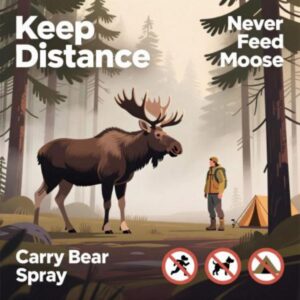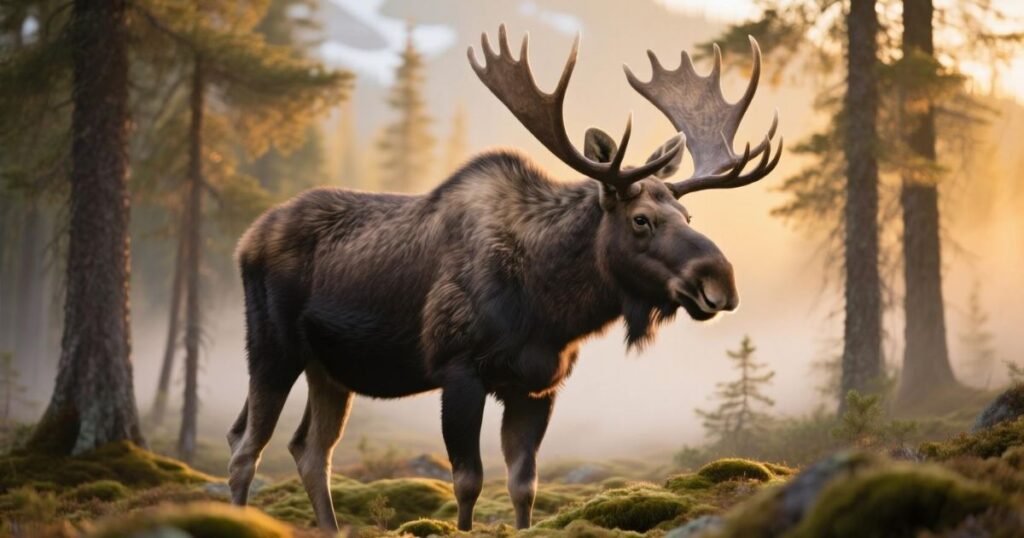The moose is one of the most iconic animals of the northern wilderness, admired for its sheer presence and power. Known scientifically as Alces alces, this giant stands tall with an impressive moose size, often reaching up to 6.5 feet at the shoulder and weighing over 1,600 pounds. Among the many subspecies, the Shiras moose is the smallest, yet it still commands attention with its unique features.
One question often asked by hikers and nature lovers is, what do moose eat? The answer lies mostly in aquatic plants, shrubs, and tree bark, making them herbivores that shape forest ecosystems. While the female moose, also called a cow, is protective of her young, the male or bull is most aggressive during the rutting season. Understanding these fascinating aspects of moose behavior is crucial to answering whether they pose a threat to humans or not.
Are Moose Dangerous to Humans?
Moose are not natural predators, but their strength makes them a real danger if provoked. Their massive antlers and unpredictable temper can quickly turn peaceful encounters into life-threatening situations. Hikers and drivers in moose habitats often underestimate the risks these giants pose when feeling threatened or cornered.
Unlike bears or wolves, moose don’t attack for food. Instead, aggression usually comes from self-defense or seasonal stress. Their kicks and charges can seriously injure humans. Reports suggest moose cause more injuries annually in North America than bears, showing they are among the most underestimated dangers in the wilderness.
The danger also increases in areas where human populations overlap with moose habitats. Towns in Alaska and Canada frequently report moose wandering into streets. Such encounters often escalate when people attempt to feed or photograph the animals, forgetting they are wild and highly unpredictable.
Why Do Moose Attack Humans?

Do Moose Attack Humans humans mainly to protect themselves or their young. Female moose (cows) are especially aggressive when defending calves. Even unprovoked, their protective instinct can trigger sudden charges. This maternal defense makes them a significant threat to hikers who unknowingly wander too close during spring or summer.
During the rutting season, bull moose become extremely aggressive. Their hormones surge, and males fight rivals using massive antlers. Unfortunately, humans are sometimes caught in this aggression. Many incidents occur when bulls mistake people, dogs, or even cars as threats, causing dangerous charges that lead to serious injuries.
Environmental stress also fuels aggression. In harsh winters, food scarcity makes moose irritable. Pets or loud noises can trigger violent reactions. People often think of moose as gentle giants, but their behavior changes drastically under stress, proving that human safety depends on respecting their space and conditions.
How Often Do Moose Attack People Each Year?
Do Moose Attack Humans are not extremely common, but they happen more often than most people think. In Alaska alone, dozens of incidents are reported annually. Though deaths are rare, injuries from trampling, kicking, or collisions occur frequently, making moose-related dangers more significant than many predators in the same regions.
Vehicle collisions with moose cause more fatalities than direct attacks. In Canada and Scandinavia, hundreds of crashes involving moose are reported every year. Due to their massive size, even low-speed collisions can be deadly for both the animal and passengers, highlighting another overlooked risk of living near moose habitats.
Globally, Do Moose Attack Humans on people are fewer than encounters with animals like dogs or snakes. However, their unpredictable behavior makes them dangerous. While statistics are hard to track, experts agree moose injure more people in North America annually than bears, reinforcing their reputation as underestimated threats.
Read More: Cape Buffalo: The African Giant You Should Know About
Signs of an Aggressive Moose You Should Never Ignore
Moose rarely attack without warning. Their body language gives clear signals before aggression. Ears pinned back, raised hackles, and stomping feet all signal rising tension. Observing these cues helps hikers avoid dangerous encounters. Ignoring them, however, can lead to sudden charges, making awareness crucial for survival in moose country.
Another warning sign is when a moose lowers its head and swings its antlers. This stance indicates it is preparing to charge. People often mistake this for curiosity, but in reality, it’s a pre-attack gesture. Recognizing this difference can mean the difference between safety and a dangerous situation.
Heavy breathing or snorting also reveals stress. Moose use vocalizations and body posture to communicate their discomfort. If you hear sharp exhales, it’s a clear sign the animal feels threatened. At this point, backing away slowly is the safest option to avoid provoking a violent response.
Moose showing excessive pacing or circling behavior are usually anxious. Such actions often precede aggressive outbursts. People should never assume these movements are harmless. Instead, treating them as warnings ensures both human and moose safety. Respecting these signals not only prevents attacks but also helps maintain coexistence in shared habitats.
When Are Moose Most Likely to Attack?
Moose aggression peaks during the rutting season in autumn. Bulls experience hormone surges, making them territorial and highly aggressive. Encounters during this time are particularly dangerous. Even approaching from a safe distance may trigger charges. Many hikers and hunters consider fall the riskiest time to cross paths with these giants.
Spring brings another dangerous period. Female moose defend calves fiercely against perceived threats. Even curious hikers or dogs wandering too close risk being charged. This maternal aggression has caused numerous incidents in North America and Europe. Respecting boundaries during calving season ensures personal safety while also reducing stress on the animals.
Winter stress also plays a role. When food is scarce and snow deep, moose become irritable. Hunger and exhaustion heighten their aggression. People living in snowy regions often encounter starving moose near roads or backyards. These stressed animals may lash out unexpectedly, putting residents and pets at significant risk.
Urban encounters further increase risks. In towns near forests, moose wander into streets during harsh winters in search of food. Unaware locals often try to feed or photograph them. Unfortunately, these seemingly harmless actions provoke aggression, leading to attacks. Human curiosity combined with seasonal stress makes such encounters particularly hazardous for both species.
Moose Attacks vs Bear Attacks: Which Is More Dangerous?

At first glance, bears seem more dangerous because they are predators, but Do Moose Attack Humans are surprisingly more frequent. While bear encounters often make headlines, moose injure more people annually. Their sheer size and territorial nature, especially in populated areas, mean humans are at greater risk during unexpected encounters with these giants.
Bears typically avoid humans unless provoked or food is involved. Moose, however, often wander into residential areas, creating more opportunities for conflict. Unlike bears, they don’t fear humans as much. This fearlessness makes moose encounters riskier, as their aggression isn’t always triggered by traditional threats, but also by proximity and curiosity.
In terms of fatality, bear attacks are deadlier. Bears attack to kill or defend territory, while Do Moose Attack Humans defensively. Most moose incidents result in trampling or severe injury, not death. However, statistics still show moose cause far more non-fatal injuries annually, making them an underestimated danger in human-wildlife conflicts.
Vehicle collisions further highlight the moose threat. Crashing into a moose is more dangerous than hitting a deer because of their immense weight and height. While bear-vehicle accidents are rare, moose collisions kill dozens of people every year. This risk makes moose encounters more common and hazardous compared to bear-related dangers.
What to Do If a Moose Charges at You
If a moose charges, never try to fight back. Instead, run quickly to the nearest solid object like a tree, car, or building. Do Moose Attack Humans rely on trampling, so barriers save lives. Standing your ground is dangerous since moose can weigh over 1,000 pounds and crush anything in their path.
Always keep distance when noticing warning signs. If you can’t escape quickly, drop to the ground and curl into a ball. Protect your head and neck with your arms. Moose often lose interest once the perceived threat is motionless. Staying calm and silent increases your survival chances during encounters.
When running isn’t an option, use terrain to your advantage. Move behind rocks, fences, or steep slopes. Moose are fast in open ground but struggle with obstacles. Creating barriers makes it harder for them to reach you. This simple tactic has saved countless hikers and outdoor enthusiasts during close encounters.
Never assume the moose won’t chase far. They often pursue threats for hundreds of feet. Keep running until you’re certain it has stopped. Many injuries occur because people slow down too soon. Remember, survival depends on speed, awareness, and not panicking. These steps significantly reduce risks during sudden moose charges.
Real-Life Moose Attack Incidents
In Alaska, hikers frequently report dangerous encounters. One notable case involved a jogger trampled while wearing headphones, unable to hear warning snorts. The moose charged without hesitation, leaving the man critically injured. This tragic event highlights why situational awareness is vital in moose country, especially during mating or calving seasons.
Canada also records numerous incidents. In Alberta, a cyclist collided with an aggressive bull moose on a trail. Despite dismounting and backing away, the animal charged repeatedly. Witnesses later described how quickly the situation escalated. Such stories remind adventurers that even non-threatening behavior can provoke violent responses from stressed animals.
Urban settings are not immune. In Anchorage, a Do Moose Attack Humans shoppers outside a grocery store. Drawn by salt residue on vehicles, it grew irritated by crowds. The animal injured several people before authorities intervened. This example shows how human environments unintentionally attract moose, increasing the frequency of encounters and accidents.
One chilling case involved a school bus in Sweden. A moose charged the vehicle after spotting its reflection in the windows, mistaking it for a rival. No children were hurt, but the bus was badly damaged. This incident underlines the unpredictable nature of moose behavior, even in seemingly safe environments.
How to Prevent Moose Attacks While Hiking
Prevention begins with awareness. Always scan trails ahead for large animals. Moose blend easily into forests, making them difficult to spot. Carrying binoculars or using caution in dense vegetation reduces surprise encounters. Hiking with others is also safer, as groups are less likely to provoke aggressive behavior compared to solitary travelers.
Stay quiet but attentive. Unlike bears, moose don’t respond well to loud noises. Avoid sudden movements or shouting when you see one. Instead, maintain distance and move slowly away. Dogs should always be leashed, as their barking often triggers aggression. Respecting personal space is the best way to prevent danger.
Timing matters. Avoid hiking at dawn or dusk when moose are most active. These hours are prime feeding times, and startling an animal then often leads to aggression. Sticking to midday treks decreases the chance of running into them. Awareness of animal activity patterns is an effective safety strategy.
Carry deterrents like whistles or trekking poles. While they won’t stop a determined moose, they may create space if used carefully. Always prioritize retreat over confrontation. Educating yourself about local wildlife before trips also reduces risk. Responsible hiking practices protect both people and animals, ensuring safer coexistence in shared habitats.
Safety Tips for Living in Moose Territory

Residents in moose regions face unique challenges. Never feed moose intentionally, as this reduces their natural fear of humans. Animals accustomed to handouts become aggressive when food isn’t provided. Secure garbage bins and store livestock feed properly. Responsible practices prevent attracting these giants to homes, reducing the risk of confrontations.
Keep yards clear of temptations. Salt left from melting ice or pet food can lure moose. Many incidents occur when animals wander too close to houses. Using fencing, removing attractants, and planting less appealing vegetation all discourage moose from lingering near residential areas, keeping families and property safe year-round.
Be cautious when driving. Vehicle collisions with moose are often fatal due to their immense size. Drive slowly in marked areas, especially at night. Moose eyes don’t reflect headlights well, making them hard to see. Installing warning reflectors along roads is one effective measure communities take to reduce accidents.
Educating children about moose safety is equally important. Kids should never approach or attempt to pet moose, even if they seem calm. Schools in moose territories often include wildlife awareness lessons. This ensures the next generation grows up understanding how to coexist safely with these massive, unpredictable creatures.
Real Moose Attack Stories That Shocked People
Alaska has documented multiple Do Moose Attack Humans on hikers during rutting season. One jogger was trampled while unaware of a nearby bull moose. Quick action by bystanders prevented serious injuries, showing how sudden and dangerous moose encounters can be when humans are unprepared.
In Canada, a cyclist faced repeated charges from a bull moose while on a forest trail. Even with careful retreat, the animal persisted. These incidents highlight that moose are unpredictable, and respecting their space is crucial to prevent injuries, particularly during mating or when mothers protect calves.
Do Moose Attack Humans More Than Other Wildlife?
Compared to bears or wolves, moose injuries are more frequent. Their defensive aggression, size, and presence in populated areas contribute to higher accident numbers. Unlike predators, Do Moose Attack Humans are mostly defensive, yet statistically, humans encounter moose danger more often in North American forests than most wildlife.
Vehicle collisions with moose surpass many other wildlife accidents. Due to their height, moose often collide with car roofs, causing fatal damage. While predators rarely cause such collisions, moose encounters create a combination of human injury risk and property damage, making them a significant concern in wildlife management areas.
Breeding
Moose breeding occurs mainly in fall. Bulls compete for mates, using antlers to fight rivals. Rutting season increases aggression in males. Mating rituals include vocal calls, physical displays, and territorial behavior. Human encounters rise during this period as bulls are less cautious and more likely to perceive humans as threats to their dominance.
Cows have one calf per year, usually in spring. Mothers are extremely protective, making encounters with humans near calves particularly dangerous. This maternal instinct ensures calf survival but also increases human-moose conflicts in forested regions, emphasizing the need for caution and awareness of moose behavior during breeding season.
Eat
Moose are herbivores, primarily consuming leaves, twigs, aquatic plants, and tree bark. Their diet changes seasonally; aquatic plants dominate in summer, while woody vegetation is more common in winter. Understanding what do moose eat helps predict movement patterns, which is essential for hikers and residents to avoid potential encounters.
Feeding habits also influence aggression. Hungry moose may approach human areas for food, increasing risk. Their large size and grazing behavior create encounters near roads and trails. Awareness of feeding patterns helps reduce conflict and provides insight into moose ecology, making coexistence safer for humans and animals alike.
Reproduction & Lifespan
Female moose reach sexual maturity around two years old. Mating occurs in fall, with bulls seeking cows in estrus. The single calf is usually born after an eight-month gestation, and survival rates depend on maternal care. Understanding reproduction helps predict aggressive behavior during calving and rutting seasons.
Moose typically live 15–20 years in the wild. Lifespan is influenced by predation, habitat quality, and human encounters. Older bulls with massive antlers can be more dangerous due to experience and territorial instincts. Knowledge of lifespan patterns aids in managing encounters and appreciating the life cycle of these majestic animals.
FAQ’S
How can I avoid moose encounters while hiking?
Stay alert, hike in groups, keep dogs leashed, observe wildlife from distance, and avoid areas with recent moose sightings, especially during rutting or calving seasons.
Are moose more aggressive than deer?
Yes, moose are larger and stronger. Their size and territorial behavior make them more dangerous than deer, particularly when protecting calves or during mating season.
Can moose attack vehicles?
Yes, moose often wander onto roads. Collisions can be deadly due to their height and weight. Drive cautiously in moose habitats, especially at dawn and dusk.
What is the safest distance from a moose?
Maintain at least 50 feet distance. Never approach, feed, or try to photograph them up close. Respecting space prevents defensive aggression.
Do moose attacks happen frequently?
They are relatively rare but more common than people expect. Most attacks occur when moose feel threatened, cornered, or during rutting and calving periods.
Conclusion
So, Do Moose Attack Humans? The answer is yes, but under specific circumstances. Moose are usually peaceful giants, admired for their massive size and impressive antlers. However, female moose protect their calves fiercely, and bulls become aggressive during the rutting season. Environmental stress, scarcity of food, and human provocation can also trigger attacks. Understanding moose behavior and recognizing warning signs, such as pinned ears or stomping feet, is essential for safety. Hikers, drivers, and residents in moose territory should always maintain distance, avoid feeding, and respect their habitat. Real-life incidents from Alaska, Canada, and Scandinavia demonstrate how quickly encounters can escalate. By following safety guidelines, knowing what do moose eat, and observing their seasonal patterns, humans can coexist safely with these majestic animals. Awareness and preparedness are the keys to preventing dangerous interactions while appreciating the wilderness they inhabit.


1 thought on “Do Moose Attack Humans? The Truth About These Giants”